| Flash allows you to make limited changes in each instance of a sound in the Edit Envelope window. You can change the start and end point of the sound (that is, cut a piece off the beginning or end of the waveform) and adjust the sound's volume. Flash offers six predefined volume edits: Left Channel, Right Channel, Fade Left to Right, Fade Right to Left, Fade In, and Fade Out. These sound-editing templates create common sound effects, such as making a sound grow gradual y louder (Fade In) or softer (Fade Out), or (for stereo sounds) making the sound move from one speaker channel to the other. To assign packaged volume effects: -
Open the document that you created in the preceding exercise. This is a 15-frame movie with an event sound that loops three times in Frame 1. -
In the Timeline, select Frame 1. -
In the sound area of the Frame Property Inspector, click the Edit button. The Edit Envelope window appears (Figure 14.35). Figure 14.35. Flash lets you perform simple sound editingfor length and volumein the Edit Envelope window. 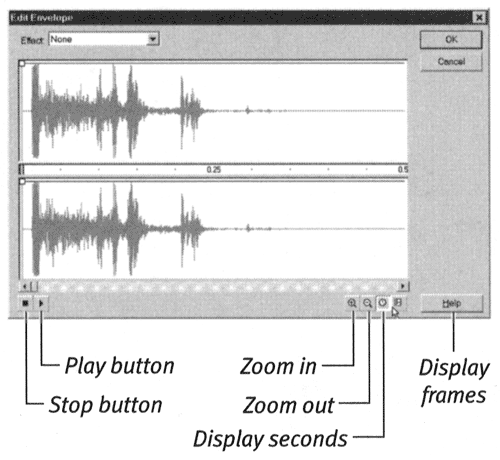 -
From the Effect pop-up menu, choose Fade In (Figure 14.36). Figure 14.36. The Effect pop-up menu in the Edit Envelope window offers six templates for common sound effects that deal with volume. You can also choose Custom to create your own effect. 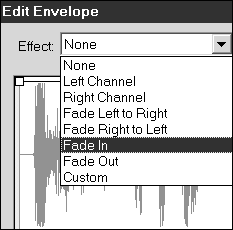 Flash adjusts the sound envelope (Figure 14.37). When the envelope line is at the top of the window, Flash plays 100 percent of the available sound. When the envelope line is at the bottom of the window, Flash plays 0 percent of the available sound. Figure 14.37. The Fade In effect brings the sound's envelope down to 0 percent (the bottom of the sound-editing window) at the start of the sound and quickly raises it to 100 percent (the top of the sound-editing window).  -
Click the Play button to hear the sound with its fade-in effect. The first iteration of the sound starts soft and grows louder. The repetitions play at full volume. -
Click OK. Flash returns you to movie-editing mode.  Tip Tip
To customize volume effects: -
Using the movie that you created in the preceding exercise, select Keyframe 1. -
To access the Edit Envelope window, in the sound area of the Frame Property Inspector, click the Edit button. -
From the Effect pop-up menu, choose Custom (Figure 14.38). Figure 14.38. To edit the volume of a sound yourself, from the Effect pop-up menu in the Edit Envelope window, choose Custom. 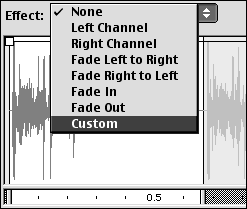 -
In the Edit Envelope window, drag the square envelope handles that appear at the 0-second mark in both channels down to 0 percent. -
In the right channel (the top section of the window), click the waveform at the 0.5-, 1.0-, and 1.3-second marks. Flash adds new envelope handles to both channels. -
In the right-channel window, at the 0.5 second mark, drag the handle up to the 50 percent volume level (Figure 14.39). Figure 14.39. Click the waveform in the sound-editing window to add a handle. Drag the handle to adjust the sound envelope. You can make the sound envelope the same or different for both channels. For monaural sounds, both waveforms are identical. 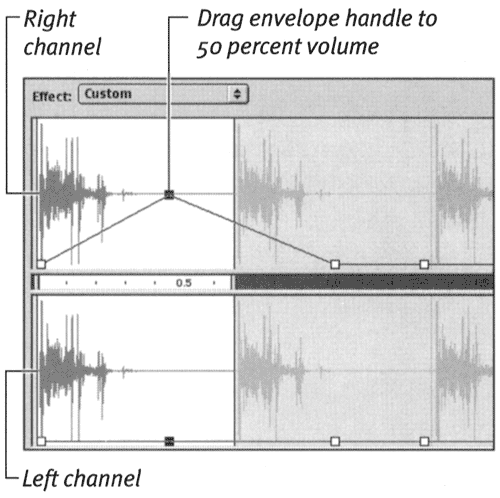 -
Repeat step 6 for the left channel. -
In both channels, drag the 1.0-second mark handles to the 50 percent level and the 1.3-second mark handles to the 100 percent level (Figure 14.40). Figure 14.40. You can use eight handles to shape a sound's envelope. By using the zoom tools to view more of the sound in the Edit Envelope window, you can see the sound envelope for all three iterations of the sound. The first fades in, the second plays at 50 percent volume, and the third plays at full volume. 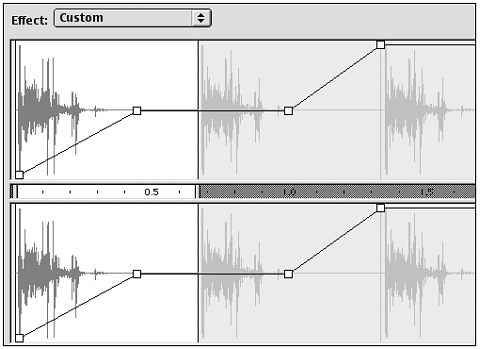 You can add as many as eight handles to create a variety of volume changes within one sound. -
Click the Play button to hear the sound with its fade-in effect. Flash fades in the first iteration of the sound, plays the second iteration at half volume, and plays the third iteration at full volume. -
Click OK.  Tips Tips -
To remove unwanted envelope handles, drag them out of the sound-editing window. -
When you ad a handle to one channel, Flash automatically adds another to the same location in the other channel. To create different volumes from the two channels, however, you can drag the handle to a different level in each channel.
In addition to changing a sound's volume, you can make a sound shorter by instructing Flash to omit some of it at the beginning, the end, or both. The Camera Shutter 35mm SLR sound has a lot of dead air (recorded silence) at the end that you can cut. To edit sounds for length: -
Using the movie that you created in the preceding exercise, select Frame 1. -
To access the Edit Envelope window, in the Frame Property Inspector, click the Edit but on. -
In the Edit Envelope window, drag the time-out control to the 0.3-second mark (Figure 14.41). Figure 14.41. Flash lets you trim the beginning and end of a sound in the Edit Envelope window. Here, dragging the time-out control clips off the end of the sound (which is just very soft sound or silence).  Flash shortens the sound in both channels (Figure 14.42). Figure 14.42. The new, shorter waveform appears in the Edit Envelope window. 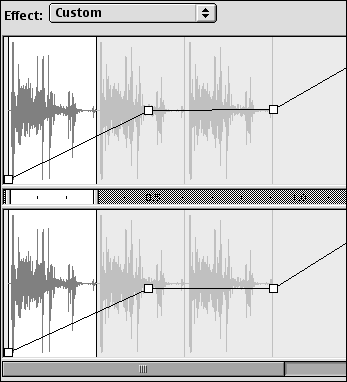 -
Click OK. Flash returns you to movie-editing mode. Now all three iterations of the looping sound are visible in the Timeline (Figure 14.43). Figure 14.43. After you shorten the sound, all three iterations fit into the 15-frame movie. 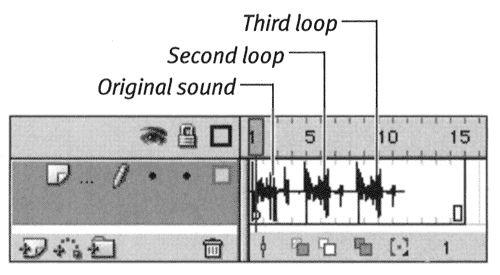  Tip Tip -
Although you can change the start and end points of a sound in Flash, you still have the whole sound taking up room in your movie file. If you find yourself trimming many sounds in Flash, you should consider investing in a sound-editing program that allows you to leave the excess on the cutting-room floor rather than behind the curtains in Flash.
 |








